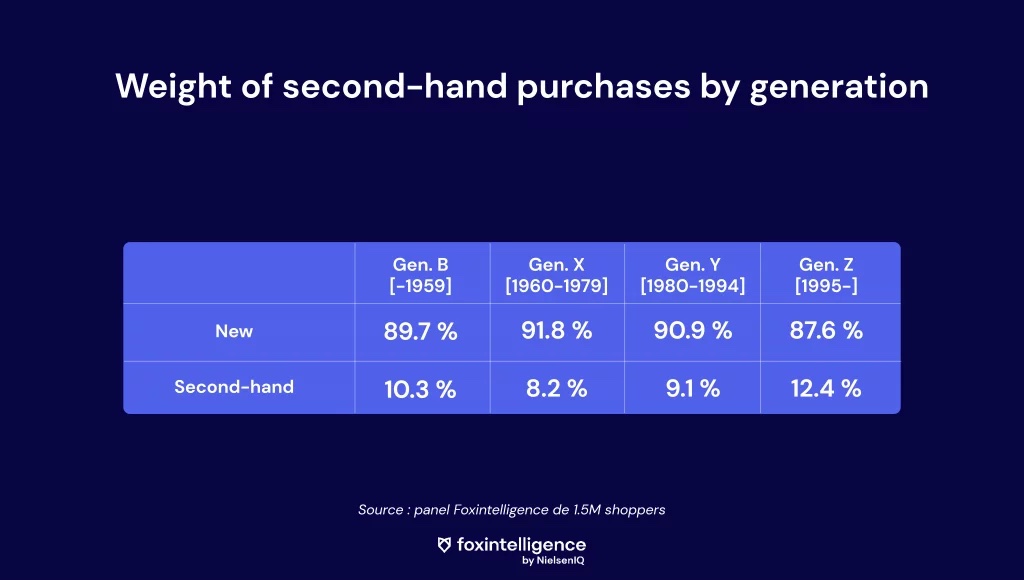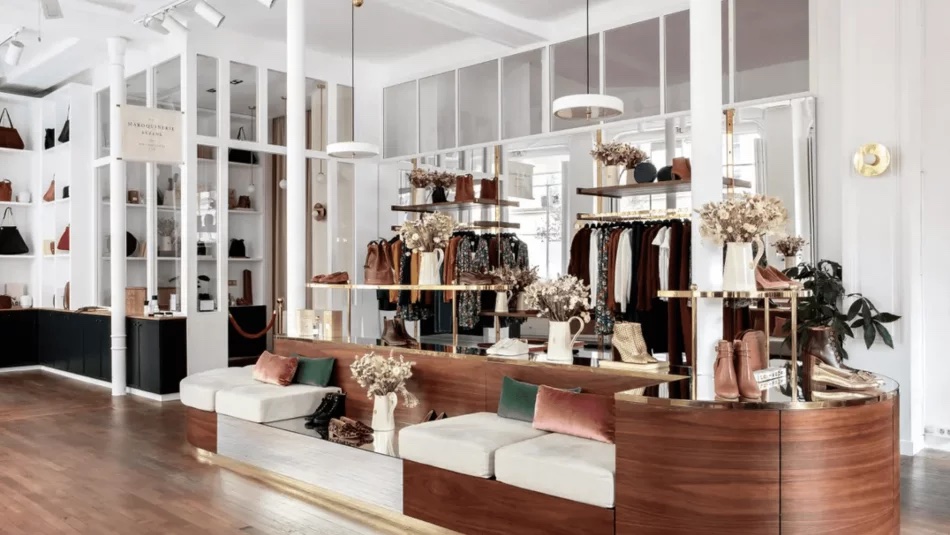Who are the real Sézane shoppers?
Most of them are Parisian
Paris sells. If we look at the market shares by region: the brand reaches 22.7% of its online market share in Paris. With 19.2% in the rest of Île de France, the Paris region accounts for 42% of the brand’s market share. A striking but falling figure compared to the 46% share in 2021.
The regions of Auvergne Rhône-Alpes (10.3% market share) and Nouvelle-Aquitaine (8%) are also strategic territories for the brand.
The Pays de la Loire and Brittany regions are the only ones where market share has increased in 2022 vs. 2021. Everywhere else, they have slightly decreased.
They use Vinted, and shop at Zara
Between 2021 and 2022, Sézane acquired 59% of new online customers – but lost 51%.
The customers lost in 2022 spent 19% of their fashion budget on Vinted, 10% at Zalando and 6% at Veepee. The brands they bought the most were Zara (6.4%), H&M (4.6%), Mango (3.6%), Nike (3.3%) and Levi’s (2.7%).
They spent 431€ on average on the Sézane website in 2022
In 2022, Sézane customers spent an average of €431 on the brand. When broken down by generation, Gen B (€347) and Gen Z (€267) spent the least at Sézane – while Gen X and Gen Y had an average spend of €499 and €481 respectively over the same year.
The products they buy the most are those that made the brand famous: knits, jeans, shirts and dresses.

Second-hand is not a second choice for Sézane customers
The second-hand figures for Sézane speak volumes and reflect the reality of the market for many brands. In 2018, second-hand represented only 3% of Sézane purchases. In 2022, that figure grew to 9.5%.
On the brand’s side, second-hand is a strategic pillar that represents real business opportunities.
For female customers, shopping at Sézane means taking a very limited risk: worst case scenario, their item sells on Vinted in just a few hours… and sometimes at a higher price than what they paid.
Second-hand purchases are common to all generations. But if we look more closely, those who spend the most on second-hand Sézane clothes are generations B (10.3%) and Z (12.4%), i.e. the generations whose average expenditure was the lowest when new.
However, the weight in value of second-hand purchases by generations X and Y is far from negligible: 8.2 and 9.1 % respectively.

The recipe for success: a well-established business model that has not changed in a decade
Storytelling & an ultra committed community: the perfect mix
Micro-collections: the founding principle of the brand
“Les Composantes” is the name of the first brand created by Morgane Sézalory. Vintage clothes and reworked pieces that she sells once a month on eBay. The revisited creations were popular, and the eBay sales quickly became a monthly event that brought together a small community.
A few years later, the designer launched Sézane – a brand that works on exactly the same principle: micro-collections for customers who subscribe to her newsletter. This gives buyers a feeling of closeness and community: the core of the brand’s DNA.
The products? Iconic, essential, impeccable quality, timeless and easily exchanged or passed on – all at reasonable prices, and produced with sustainability in mind. The pieces are sold in small quantities, and made with love – it’s written on the label, after all.
The designer as the anchor – storytelling at its finest
The name “Sézane” is a contraction of the first and last name of its designer, Morgane Sézalory. As with most luxury brands, Sézane doesn’t restrict itself to clothes, shoes and accessories – there’s a real philosophy of life behind it, a way of looking at fashion and clothes. The brand doesn’t need a muse to inspire and unite its community, it has its founder. In short, Sézane is Morgane Sézalory.
And this is probably what her community is looking for.
Sézanettes and Sézane Addicts: more than just a customer
The brand’s power of attraction is unrivalled. The aficionados are self-proclaimed “Sézane Addicts:” the name they have given to their Facebook group, which has over 66,000 members. It’s a place where they discuss the new collections, sell their treasures after having fallen for a new piece too quickly, exchange or sell goodies – totebags, notebooks, coloured pencils. Gifts from the brand that become a currency of exchange.
On Instagram, the hashtag #sezanette features on 135,000 publications and groups together the looks posted by the buyers.
Polished storytelling for the brand’s 10th anniversary
Launched in 2013, the brand hits 10 years old this year. To celebrate the event, a page has been created on the website, offering an immersive experience to Internet users:
a heartfelt letter written by the founder called “Sézane ouvre toi” that reminisces on the origins of the brand.
a podcast, “Sézane parle moi,” that promises “30 personal minutes to tell you the Sézane story.”
videos, photos, a decade of stories and memories.
the objective: nurture more affection and closeness with shoppers.
Calibrated offers & collections that sell out in a few hours: Sézane masters FOMO
Exclusive collections to increase the brand’s desirability
On the brand’s website, there is an “Essentials” category. Timeless basics – white shirts, the classic striped sailor jersey, jeans. Permanent items that have made the label famous and that can be purchased all year round.
In parallel, there are limited edition micro-collections, limited in time but above all limited in volume. The objective: to create expectation, desire and the fear of missing out – once stocks are exhausted, there is no restocking. And above all, no sales, private sales or markdowns.
Simply put: it’s now or never.
A judiciously accessible price positioning, halfway between fast fashion and luxury
Thanks to the micro-collections, price is not an issue. Marketing of rarity combined with a very loyal community: the products generally sell out in just a few minutes.
The average expenditure over the year 2022 was €431 at Sézane, for an average basket of €158. In comparison, the average basket at Zara was €55 for an average spend of €134.40 over 2022.
Halfway between fast fashion and luxury, Sézane is positioned as a semi-luxury, accessible brand like Sandro, Maje or The Kooples. However, its prices are lower.
The brand has created its own universe, with fair pricing that reflects the quality of the products sold.
Physical boutiques: a tailored experience, pampered customers
Sézane is historically a DNVB. After 3 years of exclusive sales via its website, the brand opened its first physical shop in 2016. A classic shop? Not quite. The IRL experience is unique, intimate and cosy: the boutique is called “L’Appartement Sézane” (“The Sézane Apartment,” in english). The floor creaks, you are welcomed with tea and the visit is like a cosy hug. In addition to the brand’s products, there is a lifestyle offer: decoration, tableware, stationery, household linen – in limited edition of course. All of this with a Sézane fragrance to complete the experience.
Other flats are opening in a few strategic cities. At the same time, the brand is offering ephemeral sales outlets in Europe and the United States. At the end of 2022, an Apartment opened across the Atlantic in San Francisco. On the window, the brand’s promise: “Sézane brings Paris to you.”
Self-service: a new 400m² boutique concept
In 2019, the brand opened the Sézane Self Service, a concept boutique – 400m2 on two levels. You will find the brand’s products, of course, but also vintage clothing from other brands, and collaborations with upcycling brands. Beauty products, stationery, erotic toys. The whole shebang.
A new kind of boutique where you can find a concierge area to collect your Sézane parcels, a small corner to charge your phone while reading a book. A place that invites you to take your time.
Sézane reigns supreme in the marketing of rarity and proximity. By placing customers at the heart of its strategy and offering them a polished user experience both online and offline, it is proof that digital does not signal the end of physical shops – but forces them to reinvent themselves.



